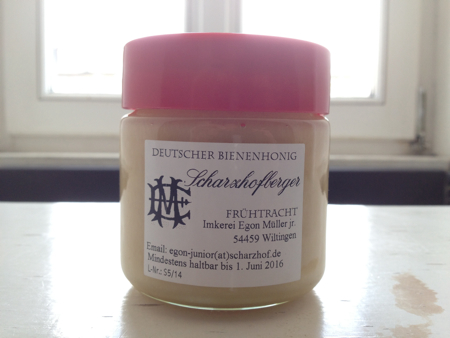- September 6, 2014
Scharzhofberger Honey
- by Lars Carlberg
 On a recent visit to Egon Müller, I purchased a few jars of Scharzhofberger honey from Egon Müller, Jr. The 14-year-old beekeeper has five bee colonies, four in Scharzhofberger and one in Trassem, in Saargau.
On a recent visit to Egon Müller, I purchased a few jars of Scharzhofberger honey from Egon Müller, Jr. The 14-year-old beekeeper has five bee colonies, four in Scharzhofberger and one in Trassem, in Saargau.
He explains on his website how he took a beginner's class for beekeeping in Saarburg, followed by a honey-training course in Bitburg, which allows him to use the official glasses and labels of the Deutscher Imkerbund e.V. (German Beekeeper's Association). He, however, decided to put his own label on a generic glass for his Scharzhofberger honey (see photo). The official name is Imkerei Egon Müller jr.
I bought myself the small jar and a bigger one for the Webers at Hofgut Falkenstein. I also gave a jar of honey to David Schildknecht, who was sitting next to me in the study at the Scharzhof. Egon Müller had just uncorked a delicious bottle of 2012 Scharzhofberger Spätlese Alte Reben. It had a beautiful pale yellow-green tint and tasted very fine. As we sat and drank the wine, I asked Herr Müller about buying some honey, but he had to find his son first. We could hear his voice in an adjacent room yelling "Egon! Egon!" ♦
- Posted in Articles, Vineyards
- | Tagged: Egon Müller – Scharzhof, honey, Imkerei Scharzhof, Saar, Scharzhofberg



On our visit, I mispronounced Honig as Hönig for some reason, but Herr Müller politely pronounced the word “honey” for me, as it doesn’t have an umlaut. After calling Egon a few times, his son came downstairs with a box of honey jars to choose from. Of course, I selected the Scharzhofberger honey. The price for the small jar is 5 euros; the large jar costs 10 euros.
So how was the honey?
This afternoon, I bought two rolls and had some butter with honey. It’s very good.
The new honey jars are fancier with an extra front label. The label in the photo is for the back label now. In addition, there is no longer a red plastic top either. The price for a 500-ml jar is 15 euros; a 250-ml jar is about 8 euros.
I preferred the simpler look for the Scharzhofberger honey, though his honey from Trassem is still in the jar used by the Deutscher Imkerbund e.V.